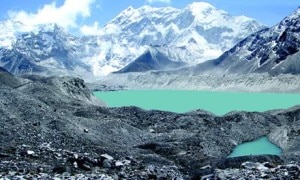Imja glacial lake more vulnerable as water level doubles in 3 yrs
KATHMANDU, Nepal- With the new study proving the water level rising at the lake Imja Tsho, which is one of the most dangerous glacial lakes in Nepal, researchers have called it a yet another sign of lake explosion.
The water volume in the lake has nearly doubled over the last three years, revealed the new study, conducted by the High Mountains Adaptation Partnership (HiMAP), coordinated by the University of Texas and The Mountains Institute (TMI) with support from the USAID.
In 2009, a study by the International Center for Integrated Mountain Development (ICIMOD) had stated that Imja Tsho, which glaciologists say was formed just half a century ago, contained about 35 million cubic meter water.
Contrary to what the ICIMOD report, the HiMAP study, conducted in September last year, says that the volume of water in Imja Tsho has increased alarmingly by 2012. The Imja Tsho now contains over 60 million cubic meter water — almost double the lake´s previously-stated water volume, the report said.
The finding of the study was revealed for the first time at the inception workshop of Community Based Flood and Glacial Lake Outburst Risk Reduction Project (CFGORRP), an initiative taken to deal with the impact of climate change in the Khumbu region, on Wednesday in Kathmandu.
The increase of water volume in Imja Lake can be related to the rise in temperature in high mountain ecosystems, the report said.
National Project Manager of the CFGORRF Top Bahadur Khatri says it is too early to conclude whether the finding of the HiMAP study is absolutely correct. “Other findings should validate what the HiMAP study states,” Khatri is quoted as saying by a report in Republica daily. “But, we have no doubt that the lake´s size and water volume are both increasing constantly.”
According to the HiMAP study, the calculated volume of water that could get discharged from Imja Lake in case of a Glacial Lake Outburst Flood (GLOF) has also increased to 34 million cubic meters. Earlier, the GLOF water was calculated to be just around 20 million cubic meters.
Assessing the risk of potential GLOF events in the Khumbu region, government authorities are no accelerating efforts to lower Imja Lake´s water level by at least three meters under the CFGORRF. After Tsho Rolpa, this is the first time that a glacial lake´s water level is likely to be lowered in Nepal. Earlier in 2000, Tsho Rolpa´s water level was lowered by three meters.
Asked whether lowering of Imja Lake´s water level by three meters, especially in view of the HiMAP study´s new finding, is sufficient to avert GLOF events in the Khumbu region, glaciologist Dr Rijan Bhakta Kayastha said, “Reduction of Imja Lake´s water level by three meters is good enough for now.”
According to Dr Shrestha, an associate professor at the Kathmandu University (KU), the height of Imja Lake´s end moraine is just 30 meters, nearly 100 meter lesser than that of Tsho Rolpa, reported the daily. “Thanks to its low end moraine, lowering of water level by three meters is adequate for now despite the increase in the water level,” he explained.
As part of the CFGORRF, funded by the Least Developed Countries (LDC) fund of the Global Environment Facility (GEF), early-warning system will also be developed in the Khumbu region. “We will follow best practices of Tsho Rolpa while lowering Imja Lake and developing early warning system in the Khumbu region,” said Khatri.


